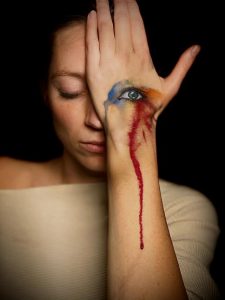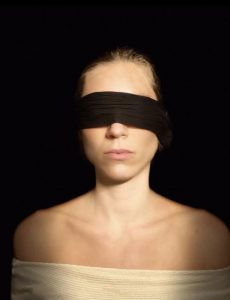14 You Don’t Need Sight to Have a Vision – Nicole Rakowski



For many individuals, the thought of losing our sight is absolutely horrifying; especially knowing how beautiful the world is and how we have been gifted with the privilege of being able to see our surroundings or those we love. The fear of losing my sight has haunted me since my youth. Ever since my tenth birthday when I required glasses to correct my nearsightedness, my vision has progressively deteriorated. Anticipating every annual eye test was filled with fear and angst.
When most people look at me, spend time with me or get to know me, they would never in a million years think that I may be someone who is visually impaired. When they look through my Instagram, hear how I speak, see how I paint, or read how I write, they’d never guess I may be living a life that is constantly challenging. The reasons for this thought process are twofold: First is that my disability is perceived to be invisible by most and second, I am known to articulate my thoughts and emotions well, which challenges the stereotype that having a disability is positively correlated with intelligence. I was diagnosed with extreme myopia far earlier than the average child should ever be. Without any corrective wear, I cannot see more than a foot away from my face.
I am often the youngest patient in the ophthalmic waiting room by at least 30 – 40 years. Most assume I arrive at the clinic to wait for my elderly family member to finish their appointment. I distinctly remember one instance where my mom had taken me to my pre-operative appointment for my retinal detachment surgery. We were sitting in the waiting room, waiting patiently for my name to be called. While looking around the room, I felt a sense of defeat knowing I was by far the youngest in the room. The waiting room was large, filled with approximately 50 patients all waiting to see several physicians. After a few moments of sitting in silence, my mom points to one lady who appeared to be in her mid-40s. My mom turns to me with a smile and says, “See, there are other young individuals waiting to be seen as well. You’re not the only one.” Part of me felt comforted knowing that other younger individuals may be going through the same situation. Not as young as me, but at least younger than the elderly patients that filled the room. After about 15 minutes, we see an elderly lady moving slowly towards the lady who is in her mid-40s. This was her mother she was waiting for as indicated by her response, “How did it go mom?”. I felt more by myself than ever, yet again.
I had my first retinal detachment at the age of 26. Second at 27. First cataract surgery at the age of 28. Numerous laser surgeries to burn epithelial cell buildups and several surgeries to burn the areas around my retinal tears in order to create scarring. This scarring helps seal the tear; almost like a glue that hardens. As a result of these surgeries, I constantly see black floaters and curtains. I was first extremely annoyed thinking there were swarms of bugs flying around my head. I later got used to these visual abstractions and now only see them when I choose to consciously think about them. My night vision is awful, and at times I hardly see anything. Headaches come in waves. It is constantly a struggle trying to balance what I see with what my brain is trying to see. Driving is challenging at times, especially when adjusting to the depth perception post any surgery. I often miscalculate my parking spots and have to adjust my vehicle several times to stay within the lines. Flashes of light and other absurdities that require emergency medical care to most, are now my new norm.
People always ask me what I see without any form of correction. The answer is nothing to make out an image. I see a blur of colours, light and that is about it. With correction, my depth perception is still off, my peripheral vision is not fully in-tact, I have a black curtain in my right field of view, I see flashes of light, I see black floaters, and on bright, sunny days, my eyes are extremely sensitive to light even with sunglasses on. I can no longer see objects close-up with my right eye due to the nature of the corrective lens that was implanted into my eye.
Just because I look fine doesn’t mean my daily life isn’t filled with challenges. I know this is relatively nothing in comparison to what some people endure. The point is that you never know what someone else may be going through, although not apparent from the visual standpoint. Supporting those that have invisible disabilities and who constantly have to explain their situation to individuals while justifying their actions is key. I’ve received glares and comments frequently from individuals saying, “Can’t you read that sign?”, assuming I am an arrogant individual who does not feel the need to obey signage and protocol – when in fact I am simply struggling to see. Other common statements: “Watch where you’re going!” “Your one eye looks funny.” “Why is your right eye so dark?” “How many fingers am I holding up?” “I feel so sorry for you.” “Right there! Can’t you see?” These questions do nothing other than remind us what an invisible disability has taken away from us.
Life at McMaster
Learning at McMaster University has been both challenging and fulfilling. To be honest, for years I was ashamed that I had a visual impairment and would often sit in silence. Viewing the presentations during lectures was a struggle. I would often have to sit in the front row or even closer in order to see the screen properly. When I was late and had to sit further back, I had to heavily rely on my hearing and other senses to understand what was being explained. Thinking back on it now, I don’t know why I didn’t simply come forward and ask for help. Perhaps it wasn’t really clear how to go about asking for help. Even if I did, how would I know whether my request would be met? I guess I wanted to feel normal like everyone else and denied the fact that I needed help and avoided the possibility of being overlooked.
Life During Covid
I am somewhat fortunate now that all lectures are held via Zoom – meaning I can expand on my screen to my choosing and never have to feel ashamed in my home environment. I can adjust my lighting, seating position, screen position and size of my view. Respectful support comes in many forms, but to me, knowing that there are supports out there is perhaps the most comforting. I never felt encouraged to come forward and speak about my vision impairment in my earlier years at McMaster University.
Vision for Accessibility Post Covid
Advocating for those that would benefit from additional supports is extremely important and creating a custom made plan for each of those students is key to their success. All needs are different and all supportive plans must account for those varying needs.
My suggestion to faculty, teaching assistants and other educational staff would be to encourage each and every one of their students to come forward if they require support, and provide them with a safe environment to do so. They should not wait for those individuals to come forward to them necessarily as many won’t admit they have an invisible disability and require support on their own – especially in fear of having their grades affected or in fear of being judged or treated differently.
I stand with those that have experienced similar struggles to myself and I encourage them to not live in shame or in fear of being judged as I once did. The moment that changed my entire perspective and encouraged me to come forward was meeting like-minded individuals, who had similar lived experiences. Although the situation was different and they were not visually impaired, they lived in shame and fear stemming from domestic abuse. Although completely undetectable from the exterior, they were struggling to cope internally. Having them share their stories made me realize that a lot of disabilities are invisible – but the way others choose to react is not invisible. Some days are more exhausting than others, putting the effort into proving our invisibility to someone – especially when life is challenging enough. We all need support sometimes. And we all need to be provided the resources we need in order to succeed and be the best version of ourselves. The visibility of disability should never dictate its perceived severity.
Image Description: The above text is accompanied by three photographs. In each, the same white woman is facing the camera in front of a black/dark background. We see her head, shoulders, and part of her chest. All three of these photographs symbolize the struggle of being visually impaired.
- In the first photograph, the woman is wearing a beige top and her mouth and right eye are closed. The left side of her face is covered by the flat back of her left hand. A blue eye, surrounded by the colours blue, green, yellow, and orange, is painted on this hand and held over the woman’s left eye. Red paint streams from the eye and down the woman’s forearm in a single line like a tear of blood.
- In the second photograph, the woman is wearing a beige, shoulder-less top. Her hair is brown and tied back, her mouth is closed, and both of her eyes are covered by a black blindfold.
- In the third photograph, the right side of the woman’s profile is in focus with the words “What you see” while the left side is blurred with the words “What I see”. The woman is wearing a white top. Her right forearm is raised, with her hand touching her right cheek. Her left arm is held across her chest, revealing a wristwatch.
